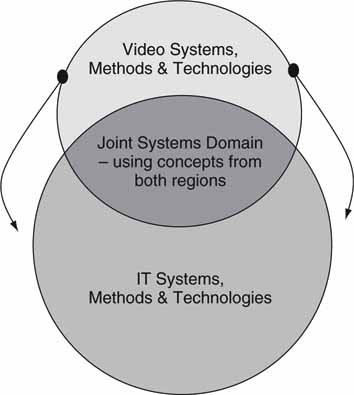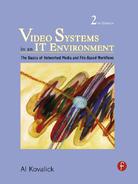Introduction
There is a tide in the affairs of men, which, taken at the flood, leads on to fortune; omitted, all the voyage of their life is bound in shallows and in miseries.
—William Shakespeare
Astute sailors know the optimal time to catch the tidal flood toward the harbor. If it is missed, a ship may be caught in a storm or stranded at sea. An able captain and crew never pass up favorable currents. Today there is a different tidal flood that many captains of ship are seeking to ride to safe harbor. What is it? It is the tidal swell of information technology (IT)1 that is being leveraged to create compelling video systems2 and file based—” tapeless”—workflows for broadcasters and other professional operations. In the big picture, we are at the emergent stages of video systems designed from hybrid combinations of IT standard platforms (storage, servers, routers, networks, firewalls, middleware, software platforms, Internet, Web services, archives, etc.) and traditional A/V methods and technology.
If you are conversant only in IT methods or comfortable only with traditional video techniques, then the hybrid combination may seem a bit strange and worrying. Will IT methods, systems, and techniques be responsive enough for the demands of real-time video? Can IT meet a 99.9999 percent reliability goal? Can you run video over and through IT-based links and switches? Will network congestion cause dropouts in your video? Will a virus or worm take you off air? Can you upgrade your system while it is in use? Will the short life spans of IT equipment lead to an unprofitable ROI and constant retooling headaches? Is using IT too risky for your demanding operations? Are the software components stable enough for mission-critical applications? Can you use A/V+IT technologies and create a “Broadcast IT” system? These and countless other concerns are discussed and resolved in this book. First, let us look a bit deeper at the interesting cross-section of A/V plus IT.
Figure IN.1 depicts the two domains of interest to us and their all important overlap. As the workflows, methods, and technology of the IT world and those of traditional video mix and combine, compelling new formulations emerge. The IT sphere consists of domain experts plus all the standard infrastructure and systems that make up IT. However, the traditional time-based media sphere consists of domain experts, video-specific links and routers, VTRs, cameras, A/V editors, on-air graphics, effects processors, vision mixers, and much more. The overlap region gathers selected components together from each domain, thereby creating IT-based media workflows.
FIGURE IN.1 The joint systems domain of hybrid AV/IT systems.

Which domain has a greater gravitational pull on the other? In 2008, IT equipment alone was estimated to be a $1.7 trillion worldwide market (source: Forrester Research), while the entire worldwide broadcast equipment market is estimated at $15 billion (source: DIS Consulting). This is about a 115:1 ratio, and the smaller of the two is drawn to the larger to take advantage of the many levers that IT can provide for video system design. The arrows in the figure imply the gradual consumption of the A/V domain by the IT domain. Almost all new A/V installations, across the board in scale, have large components of IT (see Chapter 10) Gone are the days when the exhibitors at NAB or IBC use IT as a differentiator. IT, for the most part, is becoming invisible and woven into the fabric of A/V solutions.
It is the compelling mix of A/V+IT that is our focus. Our approach is judiciously biased toward the understanding of how A/V systems can leverage IT techniques and tools. The chapters that follow cover IT in relation to the workflow needs of video systems. The intention is not to fully describe media technology but rather to explain IT in the light of video systems.
Figure IN.2 illustrates a traditional A/V system on the left and a hybrid A/V+IT system on the right. Traditional is composed of custom A/V components, specialized software, and exotic technologies—usually in small volumes. However, the hybrid mix leverages standard products from information technology and adds A/V-specific elements only as needed by the workflow requirements. Some modern hybrid systems are 90 percent IT and 10 percent A/V in terms of technology. Just a few years ago, the fabric of a typical A/V system was 90 percent A/V specific with just a pinch of IT. Chapter 1 outlines the solid business and technical motivations for the migration to hybrid systems.
FIGURE IN.2 The move to IT reduces the amount of custom A/V gear.

SCOPE OF THE BOOK
Admittedly, the world of video systems spans from the sophisticated workings of a CNN newsroom to a simple home video network. This book’s coverage will not boil the ocean. Rather, the concentration is focused on the A/V workflows used by professional broadcast, educational, government, business, and postproduction industries. There are thousands of TV stations and other video facilities worldwide that have not yet made the IT plunge, so this is timely material.
Digital A/V finds application in distribution (Web, satellite, digital cable, mobile, digital terrestrial) of content to home, business, and mobile. Home networks are catching fire too. However, our coverage focuses on production processes and not distribution or home networking. Nonetheless, many of the principles covered in these chapters are applicable to any digital A/V network.
The discussions are relevant not only to broadcasters but to media professionals in Fortune 1000 companies, government agencies, small businesses, cable MSOs, production facilities, and movie studios. Event videographers and prosumers are already seeing the gradual invasion of IT into their space.
So who are the target readers for this book?
• IT professionals—Domain experts, system administrators, directors, system engineers, security managers, CIOs, and support staff
• A/V media professionals—Domain experts, chief engineers, VPS of engineering, engineering managers, directors, systems integrators, design engineers, maintenance staff, technicians, facility planners, A/V equipment vendors, A/V sales personnel, and support staff
For media professionals, IT is framed in the context of A/V systems, i.e., in what ways can IT help do your job better. For IT professionals, A/V is framed in the context of IT systems, i.e., how can IT be used to create A/V systems. The level of coverage is moderately technical, providing practical and actionable information for the following purposes:
• Understanding the forces causing the migration toward networked media
• Explaining file-based methods and how “tapeless” concepts improve workflow efficiency contrasted to stream-based methods.
• Appreciating the basics of networked media
• Evaluating a video system’s architectures, reliability, and scalability
• Understanding the fundamentals of networking, data servers, storage systems, data archive, and security as applied to networked media
• Comprehending the fundamental industry standards that apply to IT and A/V infrastructures
• Evaluating the trends for networked media solutions and technology
• Providing insight into software platforms and their trade-offs
• Learning the support and maintenance themes for these hybrid systems
• Knowing what questions to ask of potential equipment suppliers
• Reducing the FUD3 and social uneasiness that surround/AV/IT systems
For sure, the information in this book concentrates more on IT in the context of A/V than solely on traditional A/V basics. However, Chapter 11 provides an overview of A/V basics. If you are new to A/V concepts, then it may be wise to review this chapter first.
IT means choice. Universal platforms, standards, and flexibility all embody IT. The focus of the chapters that follow is on the application of A/V plus IT methods to build, operate, and support video systems in an IT-networked environment. If all this is alien to you, do not lose hope. Hang on and this book will turn alien to familiar. Do not become a prisoner of your point of view—widen out and explore the new vistas.
So, are you going with the flow? Are you catching the tidal wave that is changing A/V systems forever? Let us ride this ship into safe harbors and enjoy the benefits of converged AV/IT systems. Yes, let us start on our journey of illuminating A/V and IT systems in the light of each other’s context.
1 The “IT” term is used throughout this book to refer to the standard platforms, systems, and methods that comprise information technology as used by business process worldwide.
2 In this book the term “video systems” includes audio systems and still graphics. As a composite, they are denoted by the term “A/V” or “AV” systems. The hybrid acronym AV/IT describes systems that use a combination of IT and traditional A/V technologies.
3 Acronyms are used throughout the book. Usually, they are explained upon introduction, whereas in other cases, no definition is provided. When in doubt, check the Glossary or Internet sources.
